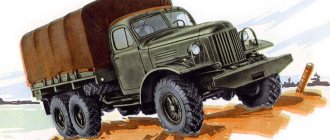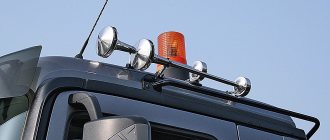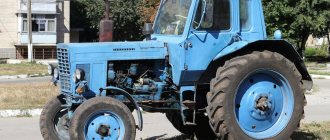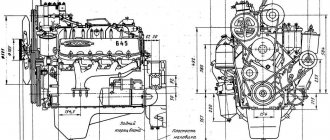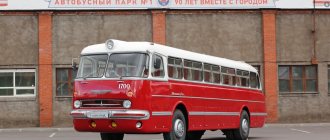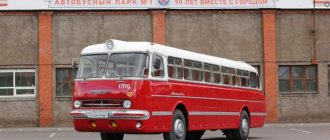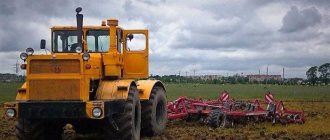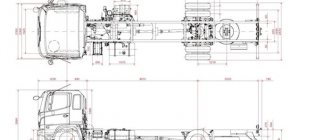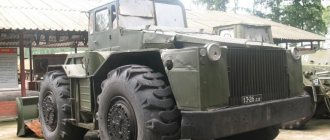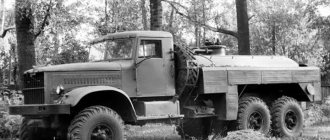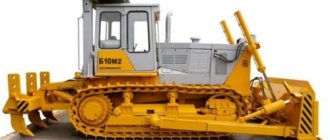The technical characteristics of the K 700 made the tractor model multifunctional. This 5-traction class wheeled vehicle is distinguished by high performance and cross-country ability.
The agricultural sector was the most developed during the Soviet Union. She could not do without reliable universal technology. The brightest representative of tractors of that time was the K 700 tractor, produced by the Kirov plant. The technical characteristics of the K 700 expand the potential for application and cross-country ability of this model.
“Steppe Giant”: 10 facts about the Soviet supertractor “Kirovets”
Let us remember a car with a colossal diesel engine, which was developed by the legendary military engineer at the suggestion of Nikita Sergeevich Khrushchev.
Over many decades, polar opinions have formed about the Kirovets monster. Some remember the mighty huge titan tactor with nostalgic warmth. Others remind the car of its sins and argue that it is now hopelessly outdated. We will not evaluate the field worker, but will simply present interesting facts from his biography and anatomy.
The K-700 “Kirovets” tractor was born, one might say, by accident. In the fall of 1959, Nikita Sergeevich Khrushchev went overseas to meet with US President Dwight Eisenhower. There, our Secretary General was given a demonstration of the John Deere factory, which to this day produces agricultural machinery. Khrushchev was then impressed by the ten-ton 8010 Goliath tractor with a 215-horsepower diesel engine. Returning to his homeland, he initiated the development of a conceptually similar machine, which was supposed to greatly help the agriculture of the USSR, which had suffered greatly during the war.
The development of the tractor was undertaken by Joseph Yakovlevich Kotin, the chief designer of the Kirov plant and the author of such legendary tanks of the Great Patriotic War as the KV (Klim Voroshilov) and IS (Joseph Stalin). Kotin's track record should also be noted - he was a laureate of four Stalin Prizes, an Honored Worker of Science and Technology of the RSFSR, a Hero of Socialist Labor, and Deputy People's Commissar of the Tank Industry.
They wanted to use the same John Deere as a prototype, but, alas, they couldn’t. Relations between the USSR and the USA deteriorated once again and it was not possible to buy the coveted tractor. But in Sweden they found a copy of the Canadian Wagner - it was used to study the design.
According to a number of sources, the Kirovets was developed as a dual-use vehicle. In peacetime, it was, in fact, a tractor. In the event of a military confrontation with Western countries, the heavyweight could perform the tasks of an artillery tractor. Fortunately, the war between the superpowers remained Cold and the Kirovets did not have to carry out missions on the front line.
The original K-700 tractor is based on two semi-frames. The front is equipped with a power unit, an axle to which the engine's traction force is constantly transmitted, a two-seater cabin and a fuel tank. The rear one carries a plug-in axle and is connected to the front one by means of an articulation. Interestingly, when maneuvering, the wheels do not turn, and a change in the trajectory of movement is ensured by folding the sections relative to each other.
The production model K-700 appeared in the early sixties and was equipped with a 220 hp diesel unit. The weight and dimensions are worthy of a mythological epic. The length is over 7 meters, the width exceeds 2.5 meters, the “height” is more than 3 meters, the weight is 11 tons. It is no coincidence that “Kirovets” received the very accurate nickname “steppe hero”.
In 1975, the K-700A and K-701, which were developments of the original model, entered the production line. They differed from the “seven hundredth” in their increased wheelbase and track, fastening of axles without springs, fuel tanks on the left and right, as well as radial tires. The K-700A modification received a 14.9-liter eight-cylinder diesel engine (235 hp and 1108 Nm). The K-701 version is even cooler - it has a 300-horsepower V12 engine with a volume of 22.3 liters! In the mid-eighties, a third generation tractor appeared, developing 335-350 “horses”. It lasted on the assembly line until the beginning of the new millennium and gave way to the new model K-744R.
Why is the fuel consumption on the MTZ80 too high, 20 liters was not enough for a day?
This model replaced its famous predecessor K-700 Kirovets, which was the first in the line of domestic high-power wheeled tractors with increased cross-country ability and for 20 years successfully served as the main machine in USSR agriculture. Cylinder heads Crankshaft Number of crankshaft bearings Main and connecting rod bearings of the crankshaft Pistons Number of piston oil scraper rings Piston pins Connecting rods Flywheel Crankcase ventilation Engine dimensions mm length width height.
General information about technology
“Kirovets” is a Soviet (and then Russian) all-terrain tractor for universal purposes, which belongs to the fifth traction class.
The machine is designed to perform agricultural tasks such as:
- Plowing.
- Cultivation.
- Loosening the soil.
- Sowing.
- Stubble peeling.
The Kirovets tractor was also used for land reclamation and road construction work. K-701 is widespread not only in Russia, but also in the CIS countries. The model appeared 10 years later than the 700th.
What oil is better to fill in the box of Kirovets K701? : Maintenance
| Tractor "Kirovets" K-700: an alternative to John Deere from the USSR. The second generation tractors began to be produced in 1975 and had a number of improvements in the main components and assemblies designed to increase the reliability and durability of the equipment. The recent war dealt a severe blow to the agricultural industry; the territories newly populated after the occupation had to be cultivated and developed again. |
| Indestructible St. Petersburg "K-700" When operating the Kirovets K-701, K-700A, K-700, K-744 tractor in special conditions of desert and sandy soils, low air temperatures, rocky soils, etc. Model Weight, t Engine power, kW Travel speed, km h Ground clearance, m Fuel tank volume, l K 701 M 14.9 246.0 30.2 0.5 640 XCMG LW520F 16.5 221.0 37.0 0.45 560. |
Is there a heat exchanger (oil-antifreeze) on the 2013 Polesie GS 12 combine? Engine YaMZ-238 • Also, many agronomists criticized the large mass of the tractor; it crushed the soil beneath it too much.
Advantages and disadvantages
Kirovets has the following advantages:
- high efficiency;
- ease of operation;
- low fuel consumption;
- maneuverability;
- maintainability;
- excellent cross-country ability.
Among the disadvantages of the technology are the following:
- noise during operation;
- possibility of a rollover due to the engine being shifted forward.
The weight of K 700 influenced the specific pressure of the equipment on the soil surface, which negatively affected the properties of the fertilized soil.
A new stage in tractor manufacturing
This newest K-700 tractor, the technical characteristics of which later helped to bring the agricultural sector of a large country out of a deep crisis, increased the speed of completing all tasks in this industry by more than 3 times.
This is the name of the car, which is the prototype of the Soviet hero. In 1959, General Secretary Khrushchev was on a business trip to the United States. He was very impressed by the capabilities that John Derre had. And when he returned home, he ordered that at the Kirov plant, which was located in Leningrad, they build a tractor that would have enormous power and high speed.
The then existing DT-54 was significantly inferior to the K-700, the technical characteristics of which seemed fantastic at that time. DT-54s could not even drive on roads, and their speed was incredibly low.
Appearance
The K-701 tractor has a simple and ascetic design. Aesthetics is perhaps the last thing that Soviet engineers cared about. After all, the country needed powerful and productive tractors.
"Kirovets" is one of the few domestic tractors that has a rotating frame. This provided the vehicle with high maneuverability. At the front there was a simple metal bumper with round headlights and turn signals. At the rear there are primitive lights and a towbar. The latter was unified with other models of the 700 series. A distinctive feature of the Kirovets is its wheels. They have equal dimensions, which are unusual for tractors, and are capable of operating at low pressure. This provides the vehicle with excellent cross-country ability. Above the front left wing there is a “pan” with an air intake. It is taken to the highest possible level. The exhaust is also located nearby. There are also side lights and additional headlights on the roof.
Exploitation
The second generation tractors began to be produced in 1975 and had a number of improvements in the main components and assemblies designed to increase the reliability and durability of the equipment. I will say right away that I was not very delighted with such trust in me, since I understood that working on such a large and complex tractor was not easy and required special skills, and, as you understand, I didn’t have them then, except theoretical knowledge.
Consumption of fuels and lubricants in agriculture
For each tractor model, fuel consumption is indicated in the operating instructions, but different manufacturers use different formulas to determine the average value. In addition, it should be borne in mind that the formulas used assume ideal conditions for the tractor to operate: it is fully loaded, a dry, smooth road, no precipitation, etc. Therefore, basically, fuel consumption is calculated for each machine individually, depending on the conditions under which the operator has to work. Let's consider the reasons why fuel consumption may increase or decrease, as well as the principle for calculating the level of fuel consumption.
Fuel consumption per hour of operation of MTZ tractors is a value that depends on the influence of many factors. Many owners of agricultural equipment believe that their machines exceed the fuel limit, and strive to find out the exact figure that would serve as a standard. Surveys and debates on forums regarding the fuel consumption rate of MTZ 82 and MTZ 82.1 show that it is not possible to obtain an exact value; two identical machines operating literally a few kilometers from each other show figures that differ in liters per hour of operation.
The average MTZ fuel consumption rate for plowing is from 5 to 12 liters of diesel fuel per hour of operation.
It is clear that such a spread does not suit many people, so they prefer to use a special formula or table with standards when making calculations.
Technical characteristics Motorcycle catalog on quto
| Tractor K-700: technical characteristics, engine, price and reviews This is one of the tractors that is widely used in large-scale work on cultivating large areas of land, building roads, and eliminating the consequences of natural disasters. They differed from the 700 in their increased wheelbase and track, axle mounting without springs, fuel tanks on the left and right, as well as radial tires. |
"Box
• It was interesting to plow on it, because the result was immediately visible, that is, a large amount of work done. » icon=»icon: recycle» icon_color=»#FF5D5D»]
Engine starting
Kirovets is equipped with a four-stroke eight-cylinder engine of the YaMZ-238NM series. Among the features of the power plant, a two-level air purification scheme can be distinguished.
Before starting the engine, make sure that the gear shift lever is in neutral.
So, let's start starting the K-700 engine:
- Remove the left fuel tank filler cap.
- Fill the tank with diesel fuel.
- Bleed the supply system with a hand pump for 3-4 minutes.
- Turn on the ground switch (the control lamp should blink green).
- Next, it is necessary to pump the lubrication mechanism of the K-700 engine to a pressure of 0.15 MPa (1.5 kgf/cm²). To do this, press the starter button.
- Sound a sound signal and move the switch, turning on the starter (a device that serves as a mechanical start).
- After starting the engine, release the “start” button.
If the engine does not start, the start can be repeated after 2-3 minutes. If after repeated attempts the engine still does not fire, you will have to find and fix the problem.
The time of non-stop operation of the electric motor of the Kirovets K-700 tractor should not exceed 3 minutes. Longer operation of the engine can lead to overheating and failure of the unit.
in winter
First we must check the serviceability of the machine components. For this purpose, it is necessary to clean the burner from carbon deposits, wash the tractor heating boiler and connect the blower motor to the circuit (12 V).
In winter, the engine of the Kirovets K-700 tractor is started in the following order:
- Connect the “+” wire to the electric motor, and connect the “-” wire to the housing.
- Open the heating boiler plug and drain the spent fuel.
- Close the plug and turn off the tap.
- Prepare water to fill the mechanism.
- Open the blower and exhaust boiler dampers.
- Open the fuel tap of the individual heating mechanism. Turn on the glow plug for 1-2 minutes.
- To start the engine, set the switch knob to the “start” position for 2 seconds and gently move it to the “run” position.
The K-700 tractor is equipped with its own “cold” start system (pre-heating mechanism). This feature makes it easier to start the engine during difficult weather conditions. You can start the equipment without any problems, even if the air temperature drops below 40 degrees below zero.
At the exhibition
The K-701 wheeled tractor is an improved version of the K-700 model. And the main changes were precisely in the technical “stuffing”. So, it was planned to install a 300-horsepower turbocharged engine from YaMZ on this equipment. But at that time, the Yaroslavl Motor Plant could not cope with such a volume of orders. Therefore, the first copies of the K-701 tractors were equipped with the old engine model 238NB. This is an 8-cylinder power unit with a capacity of 200 horsepower. Also in the lineup was the YaMZ-238ND3 engine. This diesel engine was 35 horsepower more powerful than the previous one. A little later, the K-701 tractor began to be equipped with the engine that was planned - YaMZ-240. This is a 12-cylinder V-shaped unit with a cast iron block with a capacity of 300 horsepower.
Modifications
Over the years of production, several modifications were created based on the 701st Kirovets. Among them, the 701M version was distinguished by a more high-torque YaMZ 8423 engine. With a cylinder volume of 17.24 liters, it produced 335 horsepower, which is 10.5 percent more than the YaMZ-240.
There was also a modification used as a base machine for rollers, loaders and scrapers. This is a K-702 with a modified linkage system and hydromechanical transmission.
K-703 is an industrial modification of the Kirovets. This tractor is distinguished by a reversible control post. The 703MT version was an articulated dump truck with a maximum payload of 18,000 kilograms.
Related Posts
How to carry a 4x4 discator on a T-150k (Yamz238) tractor? What gear should I work in?
- Author: Legenda The-Original
- 14 September 10:08
Good day. Has anyone carried a 4x4 discator on a T-150k (Yamz238) tractor? What gear were you working on? How it pulls. Tell me please.
how to carry on which Transmission Work Diskator T-150K diskator 4*4 Tractor YaMZ YaMZ 238
How many liters of fuel should BDST-3.6 have per hectare? Motor Yamz238
- Author: Legenda The-Original
- 01 September 22:10
Good day everyone. Guys, can you tell me how many liters of fuel this miracle needs per hectare? BDST-3.6. Motor Yamz238 as you can see
YaMZ 238 BDST-3.6 How many Liters Fuel Hectare
Is there a heat exchanger (oil-antifreeze) on the 2013 Polesie GS 12 combine? Engine YaMZ-238
- Author: Andrey Kilyakov
- 02 June 11:00
- 3 comments
Guys, is there a heat exchanger (oil-antifreeze) on the 2013 Polesie GS 12 combine? Engine YaMZ-238
is there a heat exchanger Engine YaMZ 238 Combine Harvester PALESSE GS 12 Combine Harvester Polesie 1913 Oil Antifreeze
BDT 7, Who measures the wheels? Reducing the angle of attack does not help. We wanted to process the steam, but it was too deep, we were afraid to dry out the last of the moisture.
- Author: Igor Sergeevish
- May 28 21:00
- 3 comments
Guys, BDT 7, who sands the wheels? Reducing the angle of attack does not help. We wanted to process the steam, but it was too deep, we were afraid to dry out the last of the moisture.
BDT-7 how to adjust Adjustment Discs Reduce Angle Angle of attack Does not help to process steam deeply
Why did the cylinder head gasket break on the Yamz 238? The head was recently removed and then tightened with a torque wrench. Could this be due to engine overheating?
- Author: Maxim Kitaev
- 05 May 10:29
Hi all. The cylinder head gasket on the Yamz 238 has broken. What could cause this? The head was recently removed and then tightened with a torque wrench. Could this be due to engine overheating? The temperature rose to about 95-98′ and then dropped to 80. Thanks in advance for your answers.
Why does the gasket break through the cylinder head YaMZ YaMZ 238 head Stretch the head Stretch the torque wrench Overheating Engine What could it be
Will the piston fit with YaMZ 238 turbo, or with YaMZ 236 atmo?
- Author: Evgeny Popov
- April 23 13:00
Hi all. Tell me, is the piston engine suitable for YaMZ 238 turbo, or for YaMZ 236 atmo?
Is the YaMZ 238 piston turbo YaMZ 236 atmo suitable?
To 700 yamz 238 nd5. Installed the nd5 engine. Why is antifreeze spitting out from the neck of the radiator now? What could be the problem?
- Author: Oleg Vinokurov(admin)
- 02 February 16:00
Question from a subscriber: Good day everyone. Need help with 700 Yamz 238 ND5. Installed the nd5 engine. Why is antifreeze spitting out from the neck of the radiator now? What could be the problem?
K-700 238 YaMZ YaMZ YaMZ 238 ND-5 Why does the radiator neck spit out Antifreeze Engine Installation install ND5
Which internal combustion engine should I put on the T-150 YaMZ -236 or 238?
- Author: Sergey Efimenko
- March 21, 2020
Transmission
The gearbox was unified with the 700 model tractor. A distinctive feature of this gearbox is the absence of a clutch. This function was performed by the oil drain pedal in the hydraulic system. The transmission itself had 16 speeds with spur gears. The box contains 4 hydraulic gears, two neutral and 4 mechanical. The first and last had a divider (high or low gear mode). The box also included 8 reverse speeds. Due to the clutches, gear shifting was carried out without loss of power. The speeds were activated by redirecting the oil flow. Why are there two neutral gears in this transmission? The first neutral slowed down the shaft with clutches and worked like a handbrake, so it was turned on only after the tractor had completely stopped. The second neutral cut off the hydraulic oil flow, allowing the engine to switch to one of four mechanical speeds.
A new stage in tractor manufacturing Maintenance
| Tractor K-701; Kirovets: technical characteristics, engine, fuel consumption. It is also worth noting Kotin’s track record: he was a laureate of four Stalin Prizes, an Honored Worker of Science and Technology of the RSFSR, a Hero of Socialist Labor, and Deputy People’s Commissar of the Tank Industry. At temperatures of -20 degrees and below, it is permissible to use instead of motor oils M-8 B2, M-8 A, M-8 B a mixture of 2 3 of these oils and 1 3 industrial oil I-12A GOST 20799-75 or spindle AU GOST 1642- 75. |
- Author: Vladimir Dubovskoy
- March 06, 2020
How to calculate fuel yourself? Chassis
| Consumption of fuels and lubricants, factors influencing consumption Steering control is hydraulic, using a hydraulic distributor and two hydraulic cylinders that shift the semi-frames relative to each other around a vertical hinge. Deep rutted roads; frozen or normal moisture arable land; ridge roads; thawed after a thaw; field after collecting root crops; virgin snow; off-road spring; broken roads. |
| Fuel and oil consumption rates for a tractor - calculation, formula Agricultural implement model Fuel consumption 8310R 60.2 l h 8320RT 65 l h 8335R 67.5 l h 8420R 54.8 l h 8430R 56.4 l h 8520R 58.7 l h 8530R 63 l h. Model K 701 has absorbed all the positive qualities of its ancestor, which allowed it to maintain a leading position in the domestic market for 27 years. |
- The second factor that directly affects fuel consumption is the operator's driving style.
- Weather conditions and seasonality.
- Landscape features, including the type of road surface and its current condition.
- Trailer load capacity.
